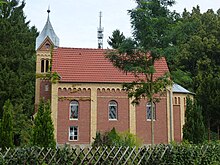Zechlinerhütte
|
Zechlinerhütte
City of Rheinsberg
Coordinates: 53 ° 9 '22 " N , 12 ° 52' 29" E
|
||
|---|---|---|
| Height : | 57 m above sea level NHN | |
| Incorporation : | October 26, 2003 | |
| Postal code : | 16831 | |
|
Location of Zechlinerhütte in Brandenburg |
||
Zechlinerhütte (Zechlinerhütte, called “hut” for short by the local population) is a formerly independent municipality and today's district of the town of Rheinsberg in the Ostprignitz-Ruppin district in northern Brandenburg . The place is surrounded by forest on Schlabornsee , here called Hüttensee. About 450 people live in the village.
Between 1737 and 1890, goblets and colored glasses were made in the “White Hut” - a glassworks . These can be seen today in the Märkisches Museum in Berlin . The founding of the glassworks was actually a relocation of the Drewitzer Hütte near Potsdam , which was founded under the Great Elector , became dilapidated and had to cease operations there in 1730 due to a lack of wood. Since the glassworks was initially administered from Flecken Zechlin , the settlement was called Zechliner Hütte. Glassmakers, glass cutters and glassblowers from Bohemia and Thuringia settled here after residential houses, the glassworks and the director's building had been built on the desert field of Zootzen in 1736 . Farm workers and shepherds also found work here, as extensive areas were also part of Zechlinerhütte. In addition to the White Hut, there was also the "Green Hut" between Luhme and the Zechlin area on the Großer Wummsee ; only green glass was made here. The White Glassworks was the only glassworks in the country to have the right to produce crystal, colored glasses and glassware with gold plating. The bailiff Siegfried Stropp had obtained approval for this from King Friedrich Wilhelm I in 1736 . This saved Prussia the expensive imports from Bohemia. In the following years families from Württemberg were settled and Huguenots expelled from France were given opportunities to settle. In 1840, due to the changed market conditions, production was switched to glass for use.
The neo-Romanesque church was built in 1881.
The memorial for the discoverer of continental drift and meteorologist Alfred Wegener , who spent several summers in Zechliner Hütte, has been there since 1969 . This memorial was originally located in the former director's house of the Weißglashütte, which was inhabited by Alfred Wegener's grandparents and by his father, the theologian and classical philologist Dr. Richard Wegener, bought in 1886 as the family's summer home. The memorial has been housed in the former Zechliner Hütte school since 1995.
During the GDR era, the place was a popular climatic health resort and a destination for guests of the Free German Trade Union Federation (FDGB).
Zechlinerhütte was incorporated into Rheinsberg on October 26, 2003.
literature
- Historical Gazetteer Brandenburg - Part 1 - Prignitz - N-Z . Modifications made by Lieselott Enders . In: Klaus Neitmann (Ed.): Publications of the Brandenburgisches Landeshauptarchiv (State Archive Potsdam) - Volume 3 . Founded by Friedrich Beck . Publishing house Klaus-D. Becker, Potsdam 2012, ISBN 978-3-88372-033-3 , pp. 1033 ff .
Web links
- Karlheinz Feistner: The Zechliner Hut and the Grün Hut. Two glassworks in the area of what is now Zechlin - have been forgotten? In: Pressglas-Korrespondenz, November 2002, pp. 100-102
- Karlheinz Feistner: Glassworks in Brandenburg - is the Mark Brandenburg a forgotten glass center? The glassworks in Zechlin . In: Pressglas-Korrespondenz, July 2005, pp. 339–343
Footnotes
- ↑ Märkische Oderzeitung, Aug. 28, 2006, p. 10
- ^ StBA: Changes in the municipalities in Germany, see 2003

